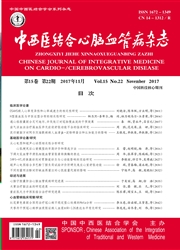

 中文摘要:
中文摘要:
目的以肾上腺素(Adr)皮下注射法建立大鼠血瘀模型,对比不同的给药剂量、给药方式和给药周期对大鼠血液流变学的影响,确定最佳的血瘀证动物模型的建立方法。方法将实验大鼠随机分为6组,即空白对照组(不造模)、急瘀1d组(Adr 1.8mg/kg皮下注射加冰水浸泡1d)、急瘀2d组(Adr 1.8mg/kg注射加冰水浸泡2d)、慢瘀小剂量组(Adr0.1mg/kg注射7d)、慢瘀中剂量组(Adr3.3mg/kg注射7d)、慢瘀大剂量组(Adr0.9mg/kg注射7d)。用血液黏度仪检测全血黏度和血浆黏度;用红细胞变形/聚集仪检测红细胞变形和聚集指数;用血凝仪检测血浆纤维蛋白原含量。结果与对照组相比,慢瘀小、中剂量组可见大鼠全血黏度、纤维蛋白原含量明显升高(P〈0.05或P〈0.01);急瘀1d组可见低切变下全血黏度升高(P〈0.05),急瘀1d组和急瘀2d组可见血浆黏度和纤维蛋白原增加(P〈0.01),急瘀2d组和慢瘀大剂量组可见红细胞变形指数明显降低(P〈0.05)。结论血瘀证动物模型戍功与否与所用的肾上腺素剂量、给药周期和给药方式密切相关。Adr0.3mg/kg注射7d和Adr1.8mg/kg注射加冰水浸泡2d大鼠出现血液流变学变化更加明显,可分别作为气郁血瘀证和气滞血瘀证的动物模型。
 英文摘要:
英文摘要:
Gbjective To testify the optimal way of using adrenaline(Adr) to establish animal model with acute or chronic Blood stasis syndrome. Methods Sprauge - Dawley rats were divided into 6 groups:Blank control group,one day acute model group(subcutaneous injection of Adr 1.8 mg/kg and soakage in ice water for one day),two day acute model group(Adr 1.8 mg/kg s. e. and soak- age in ice water for two days), low dose chronic model group (Adr 0. 1 mg/kg s. e. for consecutive 7 days), middle dose chronic model group (Adr 0.3 mg/kg s. c. for 7 days) ,and high dose chronic model group (Adr 0.9 mg/kg s. c. for 7 days). Blood viscosity,plasma fibrinogen,red blood cell(RBC)deformability and aggregation in rats were measured. Results Compared with blank control group,the whole blood viscosity and the plasma fibrinogen were increased in low dose and middle dose chronic groups(P〈0.05 or P〈0.01). The whole blood viscosity at low shear rate were increased in one day acute model group (P〈0. 05). The plasma viscosity and the plasma fibrinogen were increased in one day and two day acute model groups (P〈0.01). The RBC deformability index was decreased in two day acute model and high dose chronic model groups (P〈0.05). Conclusion Hemorrheologic changes were more significant in Adr 0.3 mg/kg s. c. for 7 days (middle dose chronic model group) ,Adr 1.8mg/kg s. c. and soakage in ice water for two days (two day acute model group). These might be taken as the animal model for syndromes of Qi - depression with blood stasis and Qi stagnation with blood stasis respectively.
 同期刊论文项目
同期刊论文项目
 同项目期刊论文
同项目期刊论文
 期刊信息
期刊信息
